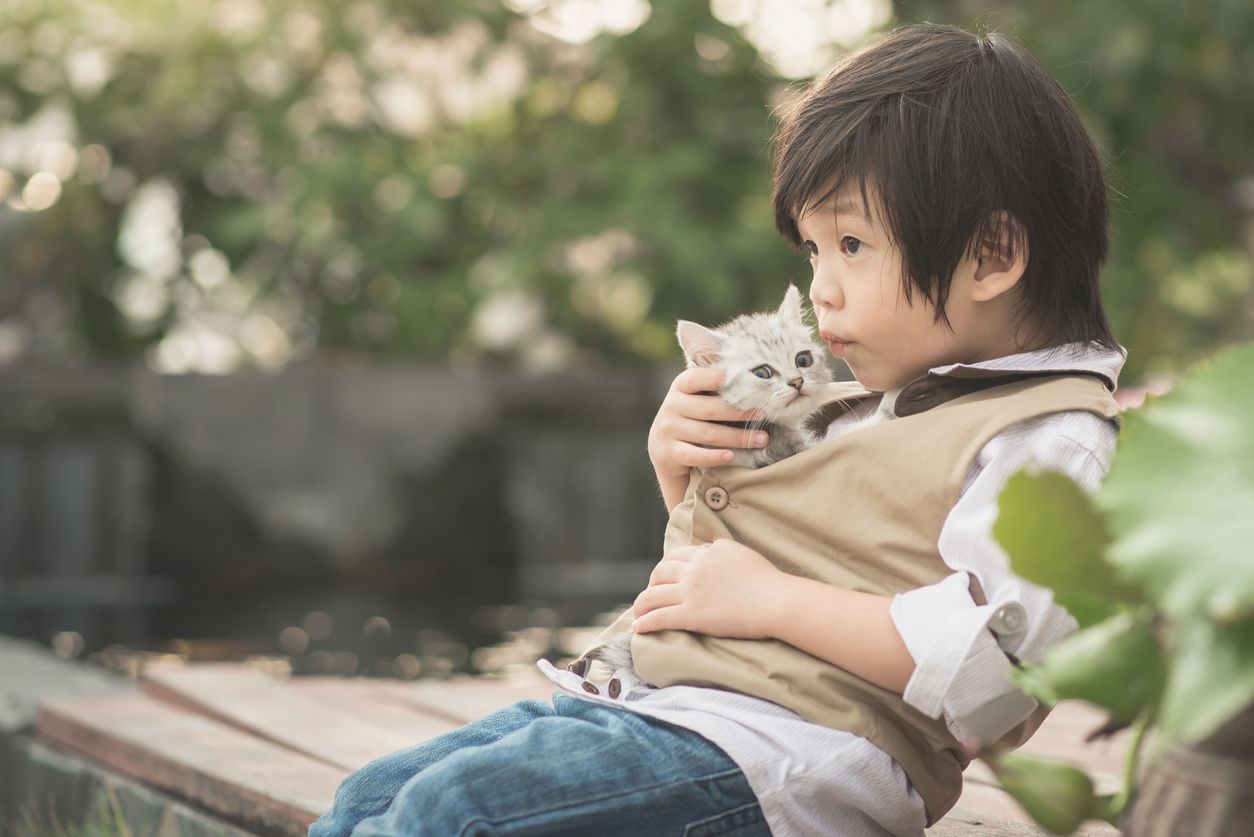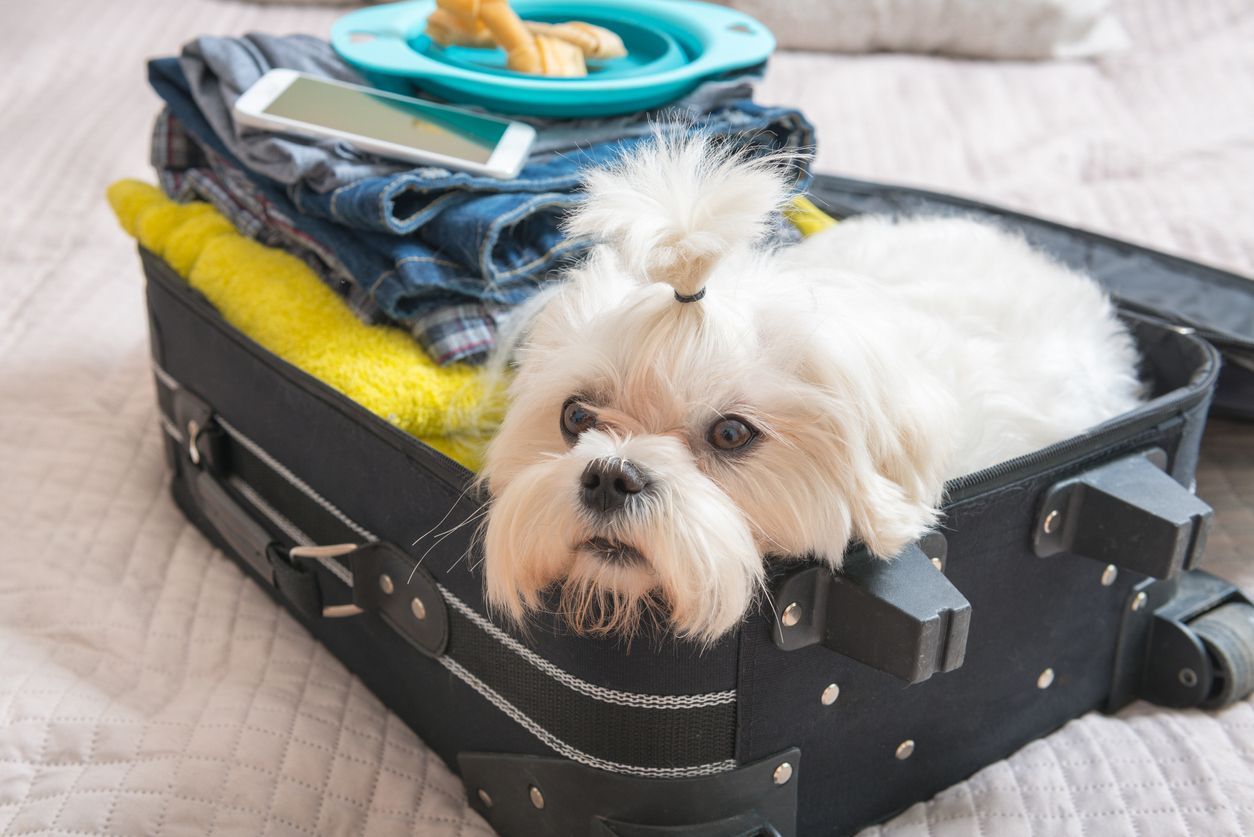How to introduce pets to your kids

What’s more heart-warming than kids and pets? Children just LOVE animals, and for good reason! There’s a special companionship that happens when our babies — both human and furry (or scaly or feathered) — come together. But the happiest pet families come from knowing the right and wrong ways to blend kids and pets.
We chatted with Vetster veterinarian Dr. Jennifer Lopez for her top tips on what you should know about introducing pets and kids in order to keep everyone safe and in harmony.
What's the best way to introduce kids and pets to each other?
Before any interaction occurs, explain to your child that they should wait for the animal to approach them. As Dr. Lopez explains, “Your kid wouldn’t want to be chased for a hug by a stranger, and neither would a dog or cat. Show them how to pet the animal gently and quietly after it comes to them.”
Make sure your child understands that it’s unwise to approach a pet at certain times. “If they startle a sleeping dog or surprise a cat and frighten it, it can be hard to know how it will react, especially if it’s new to the home, unsocialized, or on the anxious or fearful side,” Dr. Lopez says. “If you teach your kids to greet and handle animals in a way that respects their boundaries, you’ll help keep everyone safe and happy.” Outside of just introducing your pets and kids, ensure you’re taking the right steps to also introduce your pet to their new home.
How do you build a strong relationship between children and pets?
“Children are mimics, so remember that you’re their model for loving, respectful behavior,” cautions Dr. Lopez. If appropriate, get everyone involved in your pet’s care and training (feeding, going on walks, visiting the groomer). Reading books together about breeds or training techniques is another great activity to try. When your child does something nice for the pet, like fixing a leash caught between its legs, give them praise. And if they grab a furry ear a bit too hard, gently correct them. When kids understand that animals are living beings (not toys!), it paves a path of strong positive bonds.
Why is it important to build bonds between children and pets?
“The human-animal bond is very well documented,” Dr. Lopez explains, “and there’s a lot of scientific evidence showing how animals can positively impact a child’s development.” Kids with pets in their lives will show more visual attention, and they’ll laugh, wave, and coo more at animals, even toy ones. When kids have regular exposure to animals, it helps them with emotional regulation and empathy, helping them cope in hard times.
“In some ways, it's easier for younger children to form a bond with an animal because they both rely heavily on non-verbal communication and body language,” cites Dr. Lopez. “Reinforce your child's natural instinct to read and understand your pet's body language - pets learn more quickly when we speak their language instead of training them to understand ours, so messages sent with body position, posture, touch, and expression are much more likely to be received and understood when sent in either direction. For example, it’s simple and effective to teach a toddler to turn his back on a dog who is jumping on him.”
Similarly, it's easy for a very young child to learn to understand when a pet is showing classic signs of fear or aggression. Young children are highly keyed into learning all types of language in a variety of ways. Ask your child to draw the dog, for example, and ask if the dog is happy or sad. "Draw me a picture of what Sadie looks like when she's afraid." Any efforts to teach a child canine body language while they're learning verbal language will pay big dividends in creating a strong bond.
Finally, kids learn a sense of accountability and responsibility as they learn to take care of their beloved pal.
Can pets cause illnesses in kids?
“They can, but this certainly shouldn’t be a dealbreaker when it comes to owning a pet,” says Dr. Lopez. “Medicine has come so far, and there are many preventive care measures pet families can take.” Dogs owners can and should protect their dogs from flea- and tick-borne diseases, using flea and tick products. Internal parasite prevention can be a monthly treatment plan, too. Just be smart about it, and make sure that your dog or cat is getting that preventative care via regular vet check-ups in-person, or online through Vetster.
Of course! There are some breeds of cats and dogs that are less allergenic, and there’s been lots of research to enable children with allergies to still enjoy the family pet. One cat food has even been shown to reduce allergens in cat hair and dander by 47%. But this special food should be part of your toolbox for minimizing allergic symptoms. Or, consider allergy serums, which can be formulated for a specific person’s allergies. Working with your allergist and pediatrician is key: always start with a skin scratch test/exposure testing to determine if allergies are the real concern. You’ll also want to consider having a non-allergic family do most of the care and cleaning up after the pet to help reduce the allergic person’s exposure.
“And if dogs and cats are out,” says Dr. Lopez, “there’s also fish, leopard geckos, snakes, frogs, hamsters, guinea pigs, birds… the animal kingdom has so many options that make for great pets.”
What if you've adopted a rescue animal that's afraid of kids?
Identifying the root issues causing the animal to be fearful isn’t always possible, but teaching kids to be respectful and appropriate is always a good idea. “Integrate them slowly,” Dr. Lopez recommends. “Patience is always the most important part of the plan.”
To help long-term, work with professionals to help make everyone more comfortable, particularly your pet. A board-certified veterinary behaviourist, a specialized trainer, and your veterinarian can help you identify triggers, create routines of positive reinforcement, and help create a plan to work with your pet. It can be hard and slow-going, but definitely rewarding!
Most rescue organizations and shelters do a good job of screening and selecting families for pets who are afraid of children. If you notice a newly adopted pet is really afraid of your children, it’s in the pet’s best interest to contact the organization from which the pet was adopted. They can offer tips and guidance.
What are some signs you should look for that your pet is stressed out?
“Above all, pay attention to body language,” says Dr. Lopez. “Watch for a dog’s ears that are tucked back, whale eye (when you can see the whites of a dog's eyes), raised hackles, yawning, panting, or looking away from you. In cats, it’s not just growling, hissing, meowing, or aggressive behaviour. It could also be shaking, cowering, hiding, excessive grooming, or urinating outside the litterbox.”
Be sure to provide the pet with a safe haven that is off-limits to the children. The pet needs to be able to escape from unwanted interaction, and having a safe haven will help the pet develop the confidence they need to gradually warm up to the idea of interacting with the child.
Any tips for a cat owner whose child likes pulling the cat's tail?
“Poor kitty! Help your child think about what it would be like if someone was pulling an appendage on their body, and why it would hurt,” Dr. Lopez suggests. “Help them redirect their hands to gently pet the cat instead.” With repetition, they’ll learn how to handle Kitty safely and respectfully. Your cat will not only appreciate a more pain-free existence, it will also further de-stress when it’s not being chased around and having its “turf” invaded!
How can kids help take care of pets at home?
Involving kids in pet care is a great way to bring everyone together and teach cooperation and responsibility. “It helps kids to know that someone is counting on them,” says Dr. Lopez, “so find ways to involve your kids in age-appropriate pet care activities.” This could include feeding, giving water, brushing and/or washing, walking, training, litter box maintenance or poop pick-up, and giving treats. And with every activity, explain why we do all that we do for our pets.
Develop methods for tracking the tasks to encourage accountability. A daily chore chart posted on the fridge can make it easy to ensure all the pet's needs are met while also avoiding mishaps like double feedings.
What are some safe games kids and pets can enjoy together?
Animals love to play! However, not all animals love the same games, and it’s important for kids to know the signs of when an animal is playing, and when they want space.
As Dr. Lopez explains, “Cat families can have a lot of fun with prey-like play: anything that uses your cat’s instinct to hunt. Whether it’s dangly toys with feathers, noise-making mice/bird toys, or just simply running around with a long piece of string, get moving and watch the laughs begin!”
“Dog owners have all the classic things like fetch, ball, doing tricks, soccer, agility courses, and dog obstacle courses in playgrounds. Kids and dogs enjoy so many of the same kinds of fun — try playing with bubbles, or getting out the sprinklers on a hot day and having everyone chase each other around! At the end of the day, you’ll have a well-exercised, happy, and tired bunch.”
With these tips in mind, your human-and-animal family can enjoy many happy years of companionship together, making memories that tug at the heartstrings! And if any concerns crop up along the way, you can contact a Vetster veterinarian any time, day or night.




